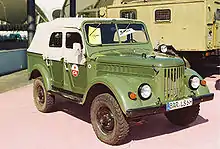| GAZ-69 | |
|---|---|
_pic1.JPG.webp) | |
| Overview | |
| Manufacturer | |
| Also called | Kaengsaeng 68 (North Korea)[1] Sungri 4.10/25 UAZ-69 |
| Production | 1953-1972 (1975 for Romania) |
| Assembly | Gorky, Ulyanovsk (USSR), Câmpulung (Romania - spare parts only) |
| Body and chassis | |
| Class | Light truck |
| Body style | 2-door cargo, 4-door field car |
| Layout | Front-engine, four-wheel-drive |
| Related | IMS-57, M59, ARO M461 UAZ-452 |
| Powertrain | |
| Engine | 2.1 L GAZ-69 I4 |
| Transmission | 3-speed manual |
| Dimensions | |
| Wheelbase | 2,300 mm (91 in) |
| Length | 3,850 mm (152 in) |
| Width | 1,750 mm (69 in) |
| Height | 1,950 mm (77 in) |
| Curb weight | 1,535–1,589 kg (3,384–3,503 lb) |
| Chronology | |
| Predecessor | |
| Successor | UAZ-469 |


The GAZ-69 is a four-wheel drive off-road vehicle produced by GAZ (ГАЗ, or Gorkovsky Avtomobilnyi Zavod, Gorky Automobile Factory) between 1953 and 1956 and then by UAZ, in 1956–1972, though all of these light truck class vehicles were known as GAZ-69s. It was also produced in Romania until 1975.[2]
Development and production
The GAZ-69 was created by the team of chief designer Grigoriy Vasserman as a replacement for the GAZ-67B that would have lower fuel consumption than its predecessor and use the same 55 hp (41 kW; 56 PS) 2.1 L (130 cu in) inline four and three-speed transmission as the GAZ-M20 Pobeda. The development process started in 1946 and the first prototypes known under the name "Truzhenik" (Toiler) were built in 1947. After extensive on-road testing, the new off-road vehicle went into production on August 25, 1953.[3] Over 600,000 GAZ-69s had been built by the end of production in the USSR in 1972. a copy of the GAZ-69 with some modifications was produced by ARO in Romania until 1975, first as the IMS-57, its main difference was that it used the GAZ-A type I4 engine (obtained by importing old Soviet tooling, as the original GAZ-69 engine was seen as uneconomical), then heavily redesigned as the IMS M59, and later modernized as the ARO M461.[4] GAZ-69s were standard military jeeps of the Eastern Bloc and client states, except Romania that used mainly the locally built ARO models.
Design
The standard GAZ-69 was able to reach 56 mph (90 km/h),[5] but more powerful versions, with 2400 cc (derived from the basic 2100 cc) 65 h.p. engines and the same three-speed gearbox, could reach 100 km/h (62 mph). They were known as the GAZ-69M, or GAZ-69AM for the four-door version.[6]
It featured two fuel tanks, one of 47 litres (12 US gal; 10 imp gal) under the floor, one of 28 litres (7 US gal; 6 imp gal) beneath the passenger's seat.[2] All civilian models also had to meet Army requirements, in case of wartime requisitioning. (This is also why a hardtop version was not available until 1993)[7] The basic variant GAZ-69 has a pair of doors and usually has standard canvas top and upper sides; there are two seats in front and two folding benches for three passengers each on sides. The further variant GAZ-69A (UAZ-69A) has four doors, folding canvas top and two rows of seats.
It was used as the basis for the rear-wheel drive van GAZ-19 that was built in 1955 but didn't pass the prototype stage. The off-road van and light truck UAZ-450 and the newer UAZ-469 also traced their origins to the GAZ-69.[6]
Military use
The GAZ-69 had been the basic light off-road vehicle of the Soviet Army, replacing GAZ-67s and Willys Jeeps, before the army adopted the UAZ-469.[6] It was also used as the basis for the 2P26 tank destroyer, as well as for the GAZ-46 MAV, a light 4x4 amphibious vehicle inspired by the Ford GPA 'Seep'.[6]
Users
 Afghanistan[8]
Afghanistan[8] Albania[9]
Albania[9] Angola
Angola Armenia[10]
Armenia[10] Bulgaria
Bulgaria Cambodia
Cambodia China[11]
China[11] Cuba
Cuba Czechoslovakia[12]
Czechoslovakia[12] East Germany[13]
East Germany[13] Egypt − 2P26 tank destroyers[14]
Egypt − 2P26 tank destroyers[14] Finland
Finland Hungary
Hungary Indonesia − around 4400 units ordered in total; first batch 4000 units ordered by government, second batch 400 units ordered by Indonesian Air Force[15]
Indonesia − around 4400 units ordered in total; first batch 4000 units ordered by government, second batch 400 units ordered by Indonesian Air Force[15] Iran
Iran Iraq
Iraq Israel
Israel Laos
Laos Lebanon
Lebanon Poland
Poland Romania
Romania Mongolia
Mongolia Syria
Syria Soviet Union[6]
Soviet Union[6] Vietnam
Vietnam North Korea
North Korea Nepal
Nepal
Many civilian use yellow coloured ones were imported in to Nepal and were successfully used in the mountain roads.
In Popular Culture
In the film Indiana Jones and the Kingdom of the Crystal Skull a GAZ-69 appears in one of the chases of the film involving Spalko and the main characters.
Gallery

![A retired GAZ-69 in the Fort aan den Hoek van Holland [nl] in Hook of Holland, Netherlands](../I/UAZ-69.jpg.webp) A retired GAZ-69 in the Fort aan den Hoek van Holland in Hook of Holland, Netherlands
A retired GAZ-69 in the Fort aan den Hoek van Holland in Hook of Holland, Netherlands A GAZ-69 of the Hungarian Army
A GAZ-69 of the Hungarian Army UAZ-69M, front view
UAZ-69M, front view.jpg.webp) UAZ-69M
UAZ-69M GAZ-69, interior
GAZ-69, interior
See also
Bibliography
- United States Department of the Army (1960). Handbook on the Satellite Armies. Headquarters, Department of the Army. Retrieved 23 December 2023.
References
- ↑ "KAENGSAENG 68KA | chinesecars". www.chinesecars.net. Retrieved 2023-10-06.
- 1 2 Thompson, Andy. Cars of the Soviet Union (Haynes Publishing, Somerset, UK, 2008), p. 70.
- ↑ "The history of the development of the GAZ-69" (in Russian). www.off-road-drive.ru.
- ↑ IMS M461, "Avtolegendy SSSR i Socstran" No. 168, DeAgostini 2015, ISSN 2071-095X (in Russian), p.3-6
- ↑ Thompson, p. 176.
- 1 2 3 4 5 Ware, Pat. The World Encyclopedia of Military Vehicles (Lorenz Books, 2010), p. 177.
- ↑ Thompson, p. 176
- ↑ Shankar, Colonel C. P. (2015). Military in Pakistan and Afghanistan A Brief History. Neha Publishers & Distributors. p. 202. ISBN 978-9380318851.
- ↑ Mitzer, Stijn; Oliemans, Joost. "The North Korea Of Europe: Listing Socialist Albania's Military Equipment". Oryx. Retrieved 23 December 2023.
- ↑ Janovsky, Jakub; Dan; Mitzer, Stijn; Oliemans, Joost; Kemal (27 September 2020). "The Fight For Nagorno-Karabakh: Documenting Losses On The Sides Of Armenia And Azerbaijan". Oryx. Retrieved 5 January 2024.
- ↑ United States Department of the Army (1960). Handbook on the Chinese Communist Army. Headquarters, Department of the Army. p. 111. Retrieved 23 December 2023.
- ↑ Department of the Army 1960, p. 73.
- ↑ Department of the Army 1960, p. 97.
- ↑ Soviet/Russian Armor and Artillery Design Practices: 1945-1995. Marine Corps Intelligence Activity. 1995. pp. II-6−II-7. Retrieved 5 January 2024.
- ↑ Tsyganov, Mikhail (2014-03-20). "Tahun 1958, Mobil Uni Soviet GAZ-69 Taklukkan Gunung Api Jawa". Russia Beyond (in Indonesian). Retrieved 2022-07-30.